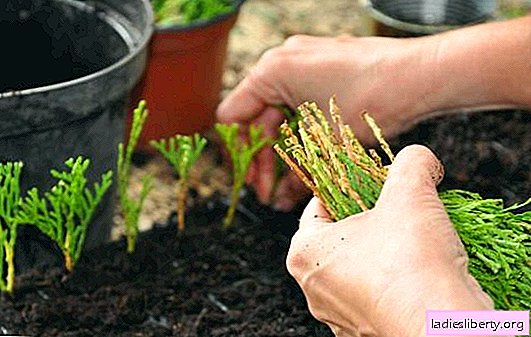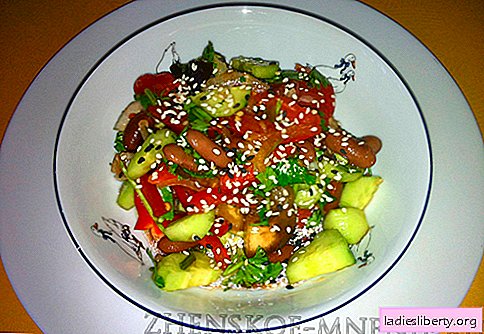
Currants are easy to grow, getting bushes with berries from white to black in the middle of summer.
It has a sour taste and is an invaluable source of iron and vitamin C.
The kitchen is used for making jam, jams, pies and other flour products, as well as for liqueurs.
Growing currants. Selection of planting material
Currant belongs to the category of perennial shrubs. Their height reaches 1.5 meters. The bush can grow up to 20 years. Flowering usually begins in late May, and the fruits ripen in July.
Light-loving plant, loves timely care and moderate watering. A necessary condition for growing currants is that it must be regularly cut and thinned.
It is considered a high-yielding and frost-resistant crop. When choosing planting material, it is necessary to pay attention to the root system, which should be: vital, not dried, branched, size - 20-25 cm. On the cut, it should be white.
Straight and smooth bark of the trunk also speaks about her health. The brown or darkened color of the currant root indicates its disease, drying out or that it froze. The better the root system is developed, the better the seedlings will take root.
It is recommended to purchase a two-year planting material.
Traditionally, currant for growing is divided into the following types:

Currant Types
• White. It is a type of red currant and differs from it only in color and taste. Its fruits are less acidic. (Versailles, Bayana, Belyana, Belaya Potapenko, etc.)
• Red. Bushes are more compact, and the berries are removed with whole brushes. Fruits are juicy and sour to the taste (Varshevich, Dutch, Red Cross, Natalie, Jam).
• Black. (Argazinskaya, Valovaya, Slastena, Gulliver, Sibilla). It has a strong and unusual flavor. It has a high content of vitamin C. Black currant is ripe when the fruit has a deep, purple-black color.
When choosing varieties of currants give preference to those that are bred specifically for your area. Create them all the necessary conditions: care, watering, feeding. It also matters for what purpose you need it. If you enjoy the taste and aroma, then a large dessert low-yielding (White currant Bayana, Natalie red, Rich black) is suitable for this. And if your goal is to grow currants for sale or to feed everyone with jam, that is, industrial currants. It is smaller berries, the taste is not so refined, but the yield is high (white currant Versailles, red jelly red, black riddle).
Also varieties differ in terms of ripening and are divided into types:
• early (White currant Belyana, Jonker van Tet red, Selechenskaya black);
• medium (White Currant Diamond, Gazelle Red, Rich Black);
• late (White currant of Bayana, Oryol star red, Delicacy black).
It is recommended to have all kinds of varieties on the site, to create the necessary favorable conditions for them to enjoy the currants all season.
Growing currants. Planting (timing, dressing, shelter, temperature, soil, etc.)
The most favorable period for planting berries is autumn. It is advisable to plant everything before the first frost, i.e. until the end of October. But do not worry if for some reason you did not have time to do it. In this case, make a spring planting as soon as possible. The reason is that with such planting, the plant will take longer to settle down and require additional care.
The necessary conditions include the fact that black currant loves a lot of sun and abundant watering, red and its types are not so demanding.
Choose a sunny place, as in the shade currant bushes are more susceptible to fungal diseases.
A few weeks before planting, implement the necessary conditions for the successful cultivation of currants: clean the soil from all perennial weeds and add a generous amount of top-dressing - well-rotten manure or compost. Currants love sour soil. To do this, put on the bottom of the chalk, old plaster, cement, egg shells or ash. You can also add a balanced fertilizer.
Dig a hole at least twice the diameter of the root ball and 40-50 cm deep, and distribute the roots for planting. Set each plant 6 cm deeper than before. Deep planting encourages the development of young, energetic shoots from the base. Mix the soil from the hole with well-swollen manure and organic fertilizer, and fill in the well.
Saplings with a small crown are planted closer to each other, and with sprawling - at a slightly longer distance. The approximate size between bushes should be 1-2 meters, and between rows - up to 3 meters.

Currant planting scheme
If the bushes are located too close to each other, then the lack of light and nutrition will affect the amount of crop when growing currants.
Putting seedling in a hole, pre-watered with water, it is necessary at an angle. This is done to better create adventitious roots and new shoots from the buds of the buried part of the root system. This contributes to the formation of a powerful and strong bush. Then you need to fill the hole with earth and irrigate gradually in the amount of up to 3 buckets of water. Some experienced gardeners recommend further around the bush to dig up the grooves at a distance of about 20 cm and pour water into them. This is necessary so that the root system receives an adequate supply of moisture. After planting, it is desirable to mumble the plant. If this process of leaving is ignored, then the moisture quickly leaves the soil, and it will be difficult for the plant to take root.
Currant can tolerate a wide range of soil conditions, but prefers well-drained, fertile, preserving the necessary conditions of moisture.
In most of the territory of Russia currant for the winter is not covered. Her bushes are quite resistant to winter weather and do not require additional care. The only thing recommended to do is to carry out mulching with a height of about 15 cm, i.e. cover the surface around the shrub with any materials that regulate the regime balance in the soil. This may be humus, compost, peat, sawdust, etc. But in some areas, protection from 40-degree frost and strong winds is necessary. To do this, press the bushes obliquely to the ground and fill it with a layer of soil.
Growing currants. Care, feeding
After planting currant care starts immediately.
• Initially cut the bushes in half or one third. This will restore the balance of the roots and give a good harvest in the first year.
• Provide enough moisture. Watering is necessary to carry out all spring and half of the summer, not allowing the soil to dry out. As a general rule, it is recommended to water the bushes in the evening so that the roots get saturated with moisture overnight. After the berries begin to turn into their colors, they stop watering. This is necessary so that the berries do not begin to crack from the excess moisture in the cell sap.
• Currant bushes need constant maintenance and renewal to ensure greater yields. Older branches will bear fruit, but the quantity and quality will decrease in proportion to age. For this reason, new bushes are planted deeply to ensure the formation of energetic young branches annually. Every year, remove about one-third of the oldest stalks. (on them the bark is very dark in color or the roots are very weak or low). Pruning is done to ground level or to a strong new escape. In the fourth year, old wood is removed at the base, leaving between 7 and 10 healthy shoots.
• The best predecessors for growing currants are sideral crops (plants that are grown to increase the fertility of the land) or grain crops. If you plant it after berry bushes, then tired soil and decaying plant debris will not allow the new bush to grow and develop. On curved terrain, place currants in the middle or lower part of the slope.
Fertilizing currant begins before planting. The hole prepared for planting should be fertilized with rotted manure, humus or compost. It is also desirable to add superphosphate, potassium sulfate, ammonium nitrate. If the soil is acidic, it is recommended to add ash and lime. This hole must be left for about two weeks to the soil settled. Immediately before planting, mix fertile soil with top dressing in order not to expose the roots to a concentrated dose of fertilizer.
The first two years with the care of this feeding will be enough. In the third year, in addition to the annual spring dressing with nitrogen fertilizer (urea), organic fertilizers, 40-50 g of superphosphate and 10-20 g of potassium sulfate are applied in the fall. Starting in the fourth year, the currant branches age faster. Urea is now recommended to make as follows: 75% of the total amount in the spring, and 25% - after flowering. Thus, fertilizer fertilizing is carried out annually, the use of organic, phosphate and potash fertilizers depends on the composition of the soil.
The main pests and diseases of currants and how to combat them
Unfortunately, black, red and white currants are subject to some types of diseases and all sorts of pests.
Consider the signs of diseases, types of pests ways to combat them:
Anthracnose (small brown spots appeared on the leaves of the currant), Septoria (white spots on the leaves). In this case, it is recommended to spray the bushes and soil with a solution (100 grams per 10 liters of water) of copper sulphate.

Anthracnose currants
• Rust. In this case, 1% Bordeaux liquid will help (100 g of vitriol + 100 g of lime per 10 liters of water).
• Mealy dew (white cobweb on currant leaves) - bushes are treated with 3% solution of ferrous sulfate, 1% solution of copper sulfate. You can use the following method: pour rotted manure with water 1: 3 and insist for 3 days. Then diluted infusion in the amount of 1: 2 to spray diseased bushes.
• Lobster currant leaves are eaten up to the veins, the caterpillars of a two-year-old moth damage berries - spraying with insecticides will help (karbofos, dichlorvos, actellic, etafos, ambush, etc.)
• Ognevka - berries ripen ahead of time and dry up. It is necessary to remove and destroy spider nests from the bushes, and after flowering, spray currants with insecticides.
• Aphid - at its invasion the currant leaves curl, dry and die. Spraying of copper sulphate, insecticides produce before the blooming of the soil. From folk remedies, you can use a soap solution (300 g of soap per 10 liters of water).
• Currant Nectary Drying - on the lower part of the branches appear bumps, which then turn black. Such branches must be cut and burned.
• Currant reversion (the appearance of flowers of an ugly form, the leaves become narrow, stretched out and seem to be terry). The main distributor of this disease is the kidney currant mite. Such a viral disease is practically not treatable. Affected bushes must be uprooted and burned.
Necessary conditions and preventive measures:
1) use healthy planting material;
2) spraying in a timely manner and taking into account all the rules. The procedure should be done before the berries bloom and after the harvest. Exercise carefully so as not to miss a single unprocessed area.
3) carry out the necessary conditions for watering and feeding shrubs;
4) remove all fallen leaves under bushes and dig the soil in the root circle;
5) do not allow the spread of weeds in the area, as they can pick up all the nutrients;
6) loosen the soil around the bushes;
7) shake the tracks, remove the web;
8) mulch the soil in spring;
9) cut and destroy the affected shoots, berries.
10) observe quarantine measures.
The hassle associated with the cultivation of currants pay off the fact that this treasure of vitamin you can enjoy a whole year.











